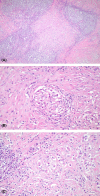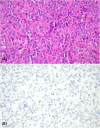Assessment and classification of sex cord-stromal tumours of the testis: recommendations from the testicular sex cord-stromal tumour (TESST) group, an Expert Panel of the Genitourinary Pathology Society (GUPS) and International Society of Urological Pathology (ISUP)
- PMID: 40528632
- PMCID: PMC12522033
- DOI: 10.1111/his.15482
Assessment and classification of sex cord-stromal tumours of the testis: recommendations from the testicular sex cord-stromal tumour (TESST) group, an Expert Panel of the Genitourinary Pathology Society (GUPS) and International Society of Urological Pathology (ISUP)
Abstract
Aims: Testicular sex cord-stromal tumours (TSCSTs) are relatively rare, accounting for ~5% of all testicular neoplasms. They were historically classified into Leydig cell tumour, Sertoli cell tumour, granulosa cell tumour, and unclassified sex cord-stromal tumour. More recently, classification was expanded to incorporate additional histologic types, including some associated with inherited cancer predisposition syndromes. However, the classification of TSCSTs still relies entirely on morphology, with some tumour types being defined based on their resemblance to ovarian counterparts. In recent years, molecular studies have identified drivers and genomic alterations associated with aggressive behaviour and progression; however, these findings have not yet impacted classification and management.
Methods and results: Under sponsorship of the International Society of Urological Pathology (ISUP) and the Genitourinary Pathology Society (GUPS), a group of genitourinary pathologists was assembled in 2023 with the aim of assessing how to use these new data to improve the classification and management of TSCSTs.
Conclusions: This paper summarizes the recommendations derived from the consensus activities and the first meeting of the testicular sex cord-stromal tumour (TESST) group (held at Johns Hopkins Hospital, Baltimore, USA, 3/23/2024).
Keywords: Leydig cell tumour; Sertoli cell tumour; granulosa cell tumour; myoid gonadal stromal tumour; sex cord‐stromal tumour; testis.
© 2025 The Author(s). Histopathology published by John Wiley & Sons Ltd.
Conflict of interest statement
The authors declare that they do not have intellectual or financial conflicts of interest pertaining to the contents of this manuscript.
Figures





References
-
- Dilworth JP, Farrow GM, Oesterling JE. Non‐germ cell tumors of testis. Urology 1991; 37; 399–417. - PubMed
-
- Thomas JC, Ross JH, Kay R. Stromal testis tumors in children: a report from the prepubertal testis tumor registry. J. Urol. 2001; 166; 2338–2340. - PubMed
-
- Young RH, Koelliker DD, Scully RE. Sertoli cell tumors of the testis, not otherwise specified: a clinicopathologic analysis of 60 cases. Am. J. Surg. Pathol. 1998; 22; 709–721. - PubMed
-
- Kratzer SS, Ulbright TM, Talerman A et al. Large cell calcifying Sertoli cell tumor of the testis: contrasting features of six malignant and six benign tumors and a review of the literature. Am. J. Surg. Pathol. 1997; 21; 1271–1280. - PubMed
-
- Cheville JC, Sebo TJ, Lager DJ, Bostwick DG, Farrow GM. Leydig cell tumor of the testis: a clinicopathologic, DNA content, and MIB‐1 comparison of nonmetastasizing and metastasizing tumors. Am. J. Surg. Pathol. 1998; 22; 1361–1367. - PubMed
MeSH terms
LinkOut - more resources
Full Text Sources
Medical

